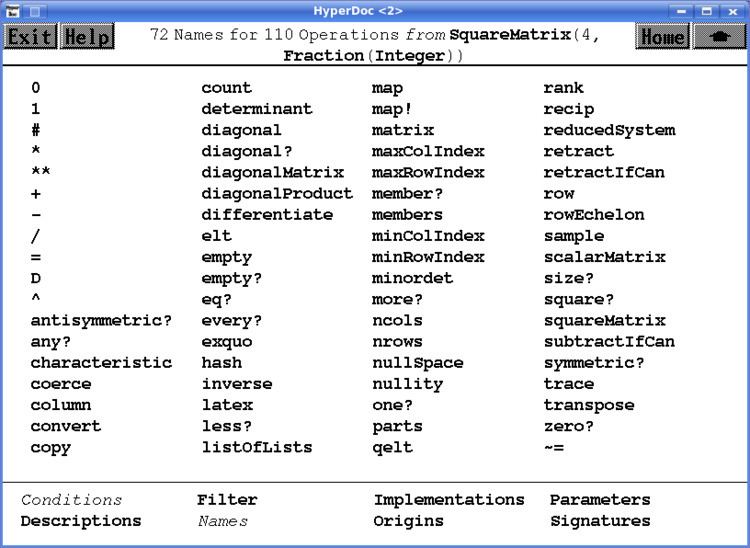Operating system | ||
 | ||
Developer(s) Independent group of people Repository git.savannah.nongnu.org/axiom.git | ||
Axiom is a free, general-purpose computer algebra system. It consists of an interpreter environment, a compiler and a library, which defines a strongly typed, mathematically (mostly) correct type hierarchy.
Contents
History
Two computer algebra systems named Scratchpad were developed by IBM. The first one was started in 1965 by James Greismer at the request of Ralph Gomory, and written in Fortran. The development of this software was stopped before any public release. The second Scratchpad, originally named Scratchpad II, was developed from 1977 on, at Thomas J. Watson Research Center, under the direction of Richard Dimick Jenks. Other key early developers were Barry Trager, Stephen Watt, James Davenport, Robert Sutor, and Scott Morrison.
Scratchpad II was renamed Axiom when IBM decided, circa 1990, to make it a commercial product. A few years later, it was sold to NAG. In 2001, it was withdrawn from the market and re-released under the Modified BSD License. Since then, the project's lead developer has been Tim Daly.
In 2007, Axiom was forked twice, originating two different open-source projects: OpenAxiom and FriCAS, following "serious disagreement about project goals". The Axiom project continued to be developed by Tim Daly.
Documentation
Axiom is a literate program. The source code is becoming available in a set of volumes which are available on the axiom-developer.org website. These volumes contain the actual source code of the system.
The currently available documents are:
Videos
The Axiom project has a major focus on providing documentation. Recently the project announced the first in a series of instructional videos, which are also available on the axiom-developer.org website. The first video provides details on the Axiom information sources.
Philosophy
The Axiom project focuses on the “30 Year Horizon”. The primary philosophy is that Axiom needs to develop several fundamental features in order to be useful to the next generation of computational mathematicians. Knuth's literate programming technique is used throughout the source code. Axiom plans to use proof technology to prove the correctness of the algorithms (such as Coq and ACL2).
Axiom uses Docker Containers as part of a continuous release process. The latest image is available on any platform using boot2docker [1] and the commands:
docker pull daly/axiom
docker run -i -t daly/axiom axiom
Design
In Axiom, all objects have a type. Examples of types are mathematical structures (such as rings, fields, polynomials) as well as data structures from computer science (e.g., lists, trees, hash tables).
A function can take a type as argument, and its return value can also be a type. For example, Fraction is a function, that takes an IntegralDomain as argument, and returns the field of fractions of its argument. As another example, the ring of SquareMatrix(4, Fraction Integer). Of course, when working in this domain, 1 is interpreted as the identity matrix and A^-1 would give the inverse of the matrix A, if it exists.
Several operations can have the same name, and the types of both the arguments and the result are used to determine which operation is applied (cf. function overloading).
Axiom comes with an extension language called SPAD. All the mathematical knowledge of Axiom is written in this language. The interpreter accepts roughly the same language. SPAD was further developed under the name A# and later Aldor. Axiom no longer supports this language extension.
Features
Within the interpreter environment, Axiom uses type inference and a heuristic algorithm to make explicit type annotations mostly unnecessary.
It features 'HyperDoc', an interactive browser-like help system, and can display two and three dimensional graphics, also providing interactive features like rotation and lighting. It also has a specialised interaction mode for Emacs, as well as a plugin for the TeXmacs editor.
Axiom has an implementation of the Risch algorithm for elementary integration, which was done by Manuel Bronstein and Barry Trager.
